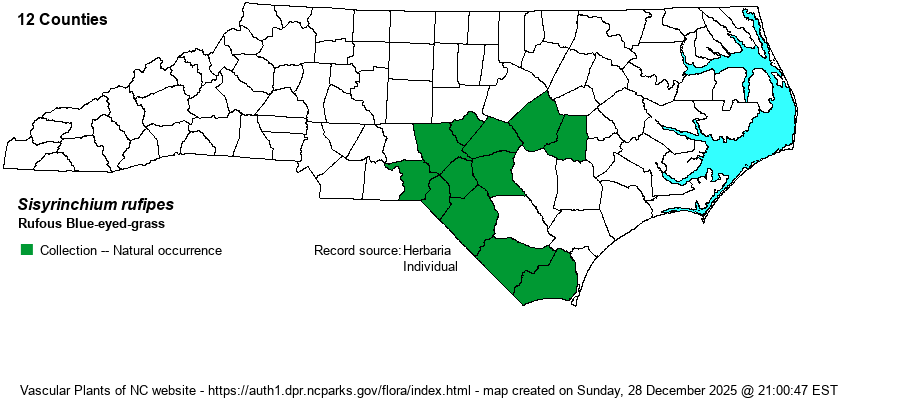| Author | Bicknell | |
| Distribution | Limited in the state to the Sandhills region, plus extensions of this range to the east to Wayne County and southeast to Brunswick County. Note that this is generally the western portion of the range of Sisyrinchium arenicola as shown on the range map in RAB (1968). Specimens at NCU and elsewhere have been annotated by Sorrie.
This is a Southern species ranging north just to eastern NC and south to northern FL, and west only to southern AL. | |
| Abundance | Fairly common to locally common in the Sandhills, but much less numerous eastward. The species is not ranked by the NCNHP, and this website gives a conservative State Rank of S3, at least for now. NatureServe does not consider it a valid species, and thus -- as Weakley (2018) does -- this website prefers to give a recommended Global Rank, of G4?Q. | |
| Habitat | This is a species of dry to xeric sandy pinelands, such as openings in Longleaf Pine sandhill communities, and it also grows on other sand ridges and sandy barrens. | |
| Phenology | Bloom from April into June, and fruits from June into October. | |
| Identification | This is a fairly typical Sisyrinchium for the most part, but with a very slender stem (about 0.1-0.2 mm wide and with very narrow wings), growing to about 6-8 inches high. There are numerous basal leaves, each about as narrow as the stem and also as long. This species has one major character that others in NC lack; the old leaves at the base contain an abundance of pale brown to reddish brown fibers, whereas in other species with an abundance of basal fibers they are brown or grayish brown in color. The flowers are typical for the genus, being mainly blue and about 0.5-0.6-inch across. The most similar species is S. fuscatum, which grows mainly to the east of the range of this species, and its narrow stem is rough/scabrous to the touch as opposed to smooth in S. rufipes. This species should not be hard to find on a walk in Longleaf Pine (Pinus palustris) stands in the Sandhills region. Thankfully, Sorrie (2011) provides one of the few photographs and species accounts available to the public, and as it focuses on the Sandhills region, the text certainly applies to the plants in NC. | |
| Taxonomic Comments | Many decades ago (such as when RAB 1968 was published), this species was lumped into S. arenicola. Both S. fuscatum and S. rufipes have been pulled from that now "defunct" species. In fact, many current references still include this species in S. fuscatum.
| |
| Other Common Name(s) | Sandhill Blue-eyed-grass, Red-based Blue-eyed-grass. Basically, this species does not have an established common name -- yet. | |
| State Rank | S2? [S3] | |
| Global Rank | GNR [G4?] | |
| State Status | | |
| US Status | | |
| USACE-agcp | | |
| USACE-emp | | |

